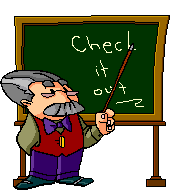 Building
a Web Page
Building
a Web Page  Building
a Web Page
Building
a Web Page
<HTML>
<HEAD>
<TITLE>
</TITLE>
</HEAD>
<BODY>
</BODY>
</HTML>
3. Save your document. Call it TASK1.TXT
Note: This means that you won't have to type these tags ever again. Next time
you start creating a page, you just open this file and then save as .HTML
4. Save As file name Task1.HTML
Putting .html after the name makes it a web page
1. Click on the button to Minimise Notepad. 
2. Open your MyWork folder by double clicking on it. If you can't see the file that you just saved, look in your MyDocuments folder.
3. Open the html file you saved by double clicking on it.
(It should have a blue ![]() on it).
on it).
The web page name is NOT the file name OR the title of the contents. It is the Name that you want to appear in the blue bar when the viewer looks at your page.
1. Open your web page
2. Right Click
3. Choose VIEW SOURCE
4. The HMTL page will appear
5. Place the cursor between the <TITLE> </TITLE> tags.
6. Type the name that you want to give your web page
[For Unit 9 - Web Page Template]
(Anything that is typed between these tags appears in the blue bar)
7. Save
8. Return to your Web Page
9. Click on Refresh
10. Whatever you typed will appear in the blue bar.
Every browser has a default font setting - a font name, size and colour that
it uses, unless you tell it to use something else. It is usually Times New Roman
12pt (or 3) and it's black. So this is how your browser will show any web page
fonts that do not have attributes set to make it show something different.
To change the setting you must use the following TAGS:
<FONT> </FONT>
You will also use the following ATTRIBUTES:
Size = "_____" Color = "_______" Face = "______"
Remember, attributes go INSIDE the start tag.
1. Open your web page
2. Right Click
3. Choose VIEW SOURCE
4. The HMTL page will appear
5. Place the cursor in front of the first word to be changed
6. Type:
7. Place your cursor between T and >
8. Type: Size="7"
(This will make the text the biggest size; the smallest size is 1)
9. Type: Color="Blue"
(Note the American spelling)
10. Type: Face="Comic Sans MS"
(This will change the font. Always check that you have the right spelling)
11. Place your cursor after the last word to be changed
12. Type:![]()
13. Save
14. Return to your Web Page
15. Click on Refresh
16. The text between the FONT tags will now be Large, Blue and Comic Sans MS.
1. Open your web page
2. Right Click
3. Choose VIEW SOURCE
4. The HMTL page will appear
5. Place the cursor between the <BODY> </BODY> tags.
6. Type or paste in your text
(Anything that is typed between these tags appears on the page)
7. Save
8. Return to your Web Page
9. Click on Refresh
10. Whatever you typed will appear on your web page.
To improve the look of your text, you can use different tags to emphasise certain words.
There are three main tags:
Bold Italic Underline
<B> </B> <I> </I> <U> </U>
1. Open your page in notepad
2. Type THIS IS BOLD
3. Place the cursor in front of the word BOLD
4. Type:
5. Place the cursor after the word BOLD
6. Type:
11. Save
12. Return to your Web Page
13. Click on Refresh
14. The BOLD will be darker than the rest of the text.
15. Now, Go back to notepad
16. Change the B tags to I tags
17. Save and Refresh, BOLD should now be BOLD
18. Return to Notepad and try the U tags
19. Next Try <B><I><U>BOLD
Remember that you must save the changes and then refresh the page before you
will see any change.
The browser doesn't recognise formatting. Unless you tell it otherwise, it just
displays the characters in a steady stream. If you want to start a new line
you have to use a line break tag <BR>.
1. Type: This is how you make paragraphs
2. Save and refresh
3. The sentence should be on one line
4. Go back to notepad
5. Type between each word like this:
This<BR>is<BR>how<BR>you<BR>make<BR>paragraphs
6. Save and Refresh
7. You should see:
This
is
how
you
make
paragraphs
Another occasionally useful tag is headings. Headings come in sizes 1 to 6.
H1 is the most important; H2 is slightly less important, and so on down to H6,
the least important.
1. Go to notepad
2. Type: <h1>An important heading</h1>
3. Type <BR> (To create a line break)
4. Type: <h2>A slightly less important heading</h2>
5. Save and refresh
6. Your page should show examples of each type of heading
A banner that moves across the top of the screen is called a Marquee.
1. Go to notepad
2. Type the following <MARQUEE BGCOLOR="RED" LOOP="infinite"
>My First Web Page</marquee>
3. Save
4. Refresh
5. Your page should show your text moving across the tope of your page.
Page Designed by Abiodun Okuyemi
![]() Email
Me
Email
Me